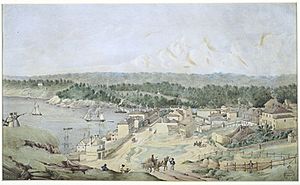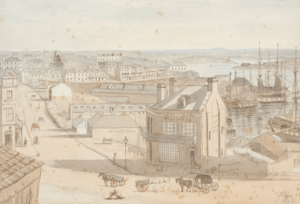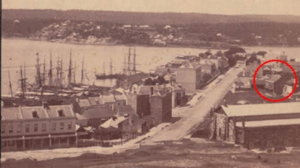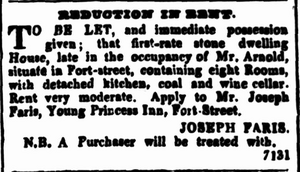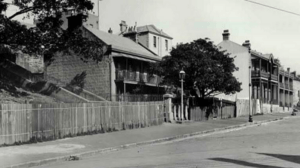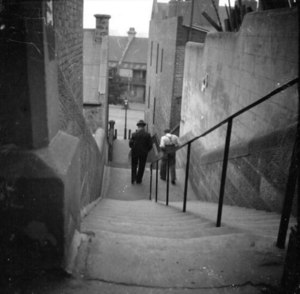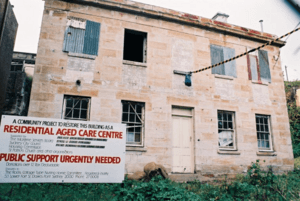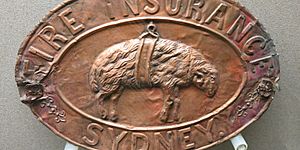Darling House, Millers Point facts for kids
Quick facts for kids Darling House |
|
|---|---|
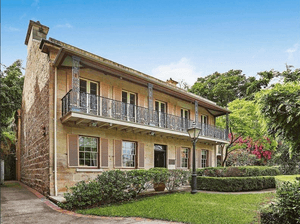 |
|
| Location | 8–12 Trinity Avenue, Dawes Point, City of Sydney, New South Wales, Australia |
| Built | c. 1835–1842 |
| Architectural style(s) | Georgian-style Old Colonial |
| Official name: Building | |
| Type | State heritage (built) |
| Designated | 2 April 1999 |
| Reference no. | 842 |
| Type | Historic site |
| Lua error in Module:Location_map at line 420: attempt to index field 'wikibase' (a nil value). | |
Darling House is a beautiful old building located at 8–12 Trinity Avenue in Millers Point, a suburb of Sydney, Australia. It's a special place because it's a "heritage manor," which means it's protected for its history and unique design.
This grand building was first built as a home for a family. Today, it's used for short-term stays, like a fancy hotel. Darling House was added to the New South Wales State Heritage Register on April 2, 1999. This shows how important it is to Sydney's history and architecture.
The house is built in the Georgian style, using strong sandstone. Parts of it might even be from an earlier building from around 1833 to 1835. The main sandstone house was built in 1842 when Joseph Farris owned it. The name "Darling House" came from the local community in the 1800s. It was named after Governor Darling, who originally granted the land.
Darling House is very important because it shows us what life was like in early colonial Australia. It's also a great example of Georgian-style architecture from that time. It's one of the few old houses in the area that still stands alone, and it's even rarer because it has lovely gardens around it.
Contents
- A Look Back: Darling House History
- What Darling House Looks Like
- Why Darling House is Important
- See also
A Look Back: Darling House History
Dawes Point, where Darling House is located, is one of the oldest places where Europeans settled in Australia. It was also a busy area for ships and port activities.
Early Days: Before Europeans Arrived
The area now known as Dawes Point had Aboriginal names like Tar-ra and Tullagalla. It was later named after Lieutenant William Dawes, an astronomer who came with the First Fleet in 1788. Before European settlement, the Cadigal Aboriginal tribe lived here.
Dawes Point is historically important for many reasons:
- It was where the first guns were set up in Sydney in 1788.
- It was home to the Dawes Point Battery, an early fort.
- Sydney's first cemetery was here.
- It was the site of Sydney's first port facilities.
This area is also often called Dawes Point or The Rocks.
European activity in Millers Point and Dawes Point began when Sydney was founded in 1788. At first, there weren't many buildings. Lieutenant William Dawes built an observatory in 1788, and "Dawes Battery" was built next to it. By 1812, there was a windmill, which was later sold to John Leighton. Because of the windmills, this part of Sydney Harbour became known as Dawes Point. There was also a slaughterhouse. The area was very rocky, making it hard to build homes.
In 1823, people started quarrying stone here. By 1830, this work helped create Argyle and Kent Streets, making the area easier to reach. As steam power became popular, the old windmills were no longer needed. The area then focused on shipping, with many wharves and warehouses built. Wealthy merchants and wharf owners started moving into Millers Point and Dawes Point. Lower Fort Street became known for its "respectable dwelling houses."
The First Building: c. 1833–1835
The land where Darling House stands was given to Susanna Ward by Governor Darling in 1823. In 1831, it was transferred to Susanna Elizabeth Douglas. Before any buildings, the site was a sandstone quarry. The sandstone blocks used to build the house likely came from this quarry, carved by convicts.
The first building on the site was probably a stone building from the early to mid-1830s. We know this because when the land was transferred in 1837, it mentioned that buildings were already there. The cost of the land also increased a lot, from £101 in 1837 to £200 in 1839.
The current sandstone building, Darling House, was built over the original one during a tough economic time in the early 1840s. Darling House still has some of the original foundations, stone walls, cobbled paths, and part of a brick wall from the early 1830s building. So, parts of the house are very old, dating back to around 1833 to 1835.
Building Darling House: Around 1840
The sandstone building we know as "Darling House" was built by Joseph Farris in the early 1840s. This was a time of great economic difficulty in Sydney. It was a large house with eight rooms, which was big for the time, as most houses in Dawes Point had only two or four rooms. Farris clearly wanted to build a stylish stone house that would fit in with the other grand homes on Lower Fort Street.
As trade and industries grew, especially with wool exports and whaling, more workers moved to the area. Darling House was built to provide homes for these growing numbers of people. Sections of Dawes Point became wealthy areas, with Argyle and Lower Fort Streets known as 'Quality Row.'
The land for the house was made up of two parts. The northern part was given to Joseph Farris, and the southern part to Michael Gannon, a local builder. Soon after, Gannon admitted that the southern part actually belonged to Farris. In 1842, Gannon officially gave the land to Farris for a small fee.
When it was built, the house had a large hallway inside. On the ground floor, there was a dining/living room on one side and two bedrooms on the other. Upstairs, there were four bedrooms on each side of the hallway. A stone kitchen and breakfast room were at the back of the house. There was also a bathroom and a wooden laundry area.
In the 1860s, verandas were added to the ground and first floors. The first-floor windows were changed into French doors. These changes were important because they showed how Australian architecture was adapting. Traditional English buildings didn't offer much protection from the sun. The French doors and verandas allowed more air to flow through the house, helping to keep it cool in the summer. These features show how Australian buildings had to be different from English ones to suit the warmer climate.
Joseph Henry Farris (1807–1859)
Joseph Henry Farris was born in England in 1807. In 1827, he inherited money after his father died. He used this money to travel to Australia with his wife, Elizabeth, arriving in Sydney in May 1830. As a free settler, Farris quickly became a successful local businessman. He worked as a boat builder, a pub owner (publican), and even a Sergeant in the water police. He was an important person in Sydney at the time and was even on the visiting list at Government House.
Farris loved building boats and competing in races. In 1832, he built the first boat ever made in Australia. He later raffled it off for £30. He was also well-known as a pub owner, running places like the Whalers Arms Hotel and the Young Princess Hotel (now the Hero of Waterloo).
It seems Farris never actually lived in Darling House. He built it as a business venture, along with three other commercial homes on Fort Street. The house was rented out to various middle-class people, including artists, musicians, teachers, and police officers. The Farris family owned the property for about 60 years until the Sydney Harbour Trust took it over in 1901.
Famous People Who Lived at Darling House (1842–1900)
The first advertisement to rent Darling House was on October 12, 1842. It described the house as a "first-rate stone dwelling House" with eight rooms, a separate kitchen, and cellars.
Many interesting people lived in Darling House over the years:
- Mr. Canham: A musician who lived there around 1844. He advertised violin and flute lessons from Darling House. He also offered to play music at parties with his band.
- Mr. John B. Edmonds: A famous book collector and bookseller who lived there around 1844. He sold a huge collection of books from the house.
- Doctor Leopold Sachs: A well-known Sydney surgeon and homeopathic doctor who lived in Darling House from 1861 to 1876. He was famous for giving free medical advice to people who couldn't afford it.
- Mrs. Rosa Strange: The wife of a famous naturalist, Frederick Strange. She lived in Darling House in the late 1870s and 1880s. She was a school teacher and ran a school in the area.
- George Baird Shaw: A Scottish painter and illustrator who lived in Darling House around 1857. While living there, he published a detailed engraving of the Lord Bishop of Sydney.
- Rosaleen Norton: Also known as the Witch of Kings Cross, she lived in Darling House when it was a boarding house in the early 1900s. She became known for her unique drawings.
The house originally had problems with bad smells from nearby toilets. The smell was so bad that people living there had to close all the back doors and windows. After Joseph Farris passed away around 1859, his wife Elizabeth Farris lived in the house. She rented out some rooms and kept birds and goats on the property.
The Plague Outbreak (1900)
The Bubonic Plague hit The Rocks and Dawes Point areas in December 1900. The first reported case was Arthur Payne, a worker in The Rocks. The New South Wales Government and Sydney Council used this opportunity to redevelop the area. They started a big clean-up and quarantine operation in The Rocks, Dawes Point, and Darling Harbour.
The Sydney Harbour Trust was created in 1901. It was given strong powers to rebuild, reclaim land, build new structures, and manage Sydney's port facilities. Between 1900 and 1902, the Sydney Harbour Trust took over almost all properties in The Rocks, Dawes Point, and Darling Harbour. This was done to clean up the area and stop the spread of the plague.
Sydney Harbour Trust Takes Over (1901)
On December 29, 1900, the Sydney Harbour Trust announced it was taking over Darling House. This happened in 1901 under a special law. Darling House was lucky to survive this time, as many houses in the area were considered unhealthy and were torn down.
After the Sydney Harbour Trust took over, Darling House was quickly turned into a boarding house. The State Government of New South Wales rented out rooms for people to live in. In 1948-49, Darling House was changed into a warehouse. Most of the inside walls were removed to allow vehicles to access the back of the house. After that, various businesses rented the house. The last known business was Lep Transport, which even installed a petrol tank on the property. After Lep Transport left, the house became empty and started to fall apart.
The southern part of the site, which was a separate piece of land, remained empty for a long time. Some old maps show a shed might have been there. Local residents from the early 1900s remember the empty site being used for an outdoor cinema and a plasterer's workshop. Around 1918, records show the site was rented to Charles Rasmussen & Co., who made and repaired barrels. There was a one-story brick building with two rooms on the land at that time.
Caraher's Stairs
In 1857, Caraher's Stairs were built next to the northern wall of Darling House. These stairs helped local residents get up to Princes Street (where the Sydney Harbour Bridge is now). They were named after Owen Joseph Caraher, a local soap merchant. The stairs were a very busy pathway, connecting Dawes Point to central Sydney.
The stairs were used so much that people complained about them being dirty. In 1900, a local committee wrote a letter saying that people were "continually lounge about them and cover the steps with expectoration, tobacco juice etc." They asked for the stairs to be swept daily and hosed twice a week because they were "almost impassable to ladies who wish to keep their dresses clean."
In 1933, the stairs were torn down as part of the construction of the Sydney Harbour Bridge. Small parts of the stairway still remain today at the northern edge of Darling House. You can see a piece of the original sandstone wall and a darker color in the brickwork of the building, showing where the stairs once were.
Becoming The Rocks Cottage Nursing Home (1994)
In 1994, Darling House went through big renovations. A new building was also constructed on the southern part of the land. All this was done to turn the house into a nursing home for the elderly. This project was a community effort, supported by local residents and a committee. It opened on October 4, 1994, and was run by the community until 2015.
In 2014, the New South Wales Government decided to sell 293 government-owned houses in Dawes Point to private buyers. This continued until 2018. In 2015, the government decided to greatly increase the rent on Darling House. This led to the nursing home closing and the property being sold.
Dr. Shane Moran Buys and Restores Darling House (2016)
In February 2016, the empty and run-down Darling House was bought for $7.7 million by Dr. Shane Moran at a public auction. Dr. Moran had also helped own and restore another historic Sydney property called Swifts, Darling Point. After buying Darling House, Dr. Moran said he planned to restore the original Georgian house and its additions. He wanted to turn it into a high-end aged care residence or seniors' living facility, making sure the original Georgian features were brought back.
The Chairman of the Millers Point Resident Action Group, Mr. John McInerney, was upset about the sale. He said the government had "taken a community facility, cashed it in for $7 million odd dollars and has now made it inaccessible to the bulk of residents around here."
From 2016 to 2019, the property underwent a major restoration and upgrade. The goal was to keep the original historic building's character while making it suitable for modern luxury seniors' living. The extensive work, lasting over three years, included:
- Completely replacing the slate roof.
- Installing cedar woodwork and staircases throughout.
- Restoring original marble fireplaces.
- Adding old leadlight windows and doors.
- Upgrading the building to modern safety standards.
- Integrating all modern technology and systems.
During the restoration, a rare and original fire insurance mark from the Sydney Fire Insurance Company, dating to around 1844, was found. Fire marks were displayed on properties insured against fire because there were no public fire brigades in New South Wales at that time. This copper fire mark showed the company's name and a golden fleece, which was a symbol of safety and security due to the growing wool industry. The golden fleece has now been adopted as the emblem for Darling House, representing its history and connection to security.
What Darling House Looks Like
Darling House is a two-story house made of sandstone in the Regency style. It has been newly renovated. With a new building on the land next door, it is now a special assisted living facility with nine independent suites.
- Five french doors open onto a second-story balcony.
- The balcony has a metal balustrade (railing) and veranda posts.
- The main roof and veranda roof are made of corrugated galvanized iron, painted with wide stripes.
- The lower story has four sash windows and an entrance door with a fanlight (a window above the door).
- The house has two main stories, plus attics.
- It is built with sandstone, a Welsh slate roof (which was fully replaced during the recent restoration), cast iron and painted metal railings, old timber woodwork, stained glass windows, historic marble fireplaces, and parquetry flooring.
- Its style combines Georgian, Regency, Victorian, and Late Twentieth Century elements.
Why Darling House is Important
As of November 23, 2000, Darling House is a great example of how old buildings can be updated with new construction while keeping their historic feel. It is part of the Millers Point Conservation Area, which is a well-preserved residential and maritime area. This area has homes and public spaces from the 1830s and shows how the landscape was changed in the 19th century. Darling House was listed on the New South Wales State Heritage Register on April 2, 1999.
Darling House is recognized as important at national, state, and local levels. It was on the (now closed) Register of the National Estate, is on the New South Wales State Heritage Register, and is part of the Sydney Local Environment Plan. Because it is located within and called the "crown jewel" of Dawes Point, Darling House is also included in other heritage listings for the Millers Point/Dawes Point area, such as the Millers Point and Dawes Point Conservation Area.
See also
- Australian residential architectural styles
- Juniper Hall, Paddington


